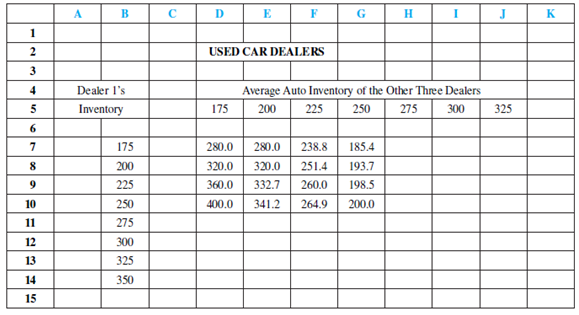Four large used-car dealers compete for customers in a city where demand for used automobiles is constant
Question:
Four large used-car dealers compete for customers in a city where demand for used automobiles is constant at about 800 cars per month. By an implicit agreement, the dealers set comparable prices on their cars, with the result that price wars and competitive discounting are extremely rare. All dealers claim to have the lowest prices, but the facts say otherwise. The average (variable) cost of a used car to the dealer (procuring and readying it for sale) is $2,400.
The average sale price per car is $4,000. The dealers do compete with respect to the number and types of cars in their showrooms. The typical prospective buyer visits a number of dealers looking for the “right” car. The greater the number of cars a dealer has available, the better is its chance of making a sale. In fact, a particular dealer’s share of the total market is proportional to the number of cars it holds in its showroom. Thus, dealer 1’s profit can be expressed as ????1 = 3,200,000[x1 ∕ (x1 + x2 + x3 + x4)] – 2,400x1. The profit expressions for the other dealers are analogous.
The partial spreadsheet that follows lists the profit of a typical dealer (for various inventories) when it faces competitors with different average inventories. For instance, if dealer 1 stocks an inventory of 250 cars when the other dealers do likewise, then dealer 1’s inventory is 25 percent of the total. Thus, it sells exactly (.25)(800) = 200 cars at a price of $4,000 each, while paying for 250 cars at $2,400 each. Its net profit is $200,000.
a. Create a spreadsheet to complete the entries in the following payoff table. Hint: To compute cell G10, enter the formula:
= 3200 * $B10 / ($ B 10 + 3 * G $ 5) − 2.4 * $B10.
Then simply copy this formula into the other cells of the table. (Adding dollar signs creates the appropriate absolute references to the dealers’ inventory levels. For the row player’s action, the sign always goes before the alphabetical coordinate, $B10. For the column player’s action, it goes before the numerical reference, G$5.) Also, in cells D7-D10 and E7, dealer 1 sells its entire inventory; thus, its payoffs are computed accordingly.
b. Find dealer 1’s best inventory response to the various inventory actions of the other dealers. (Circle the greatest profit entry in each column of the table.)
c. What is the equilibrium inventory level for each of the four dealers?
d. If the dealers colluded to limit inventories, what would be the maximum monopoly profit they could earn collectively? Would individual dealers have an incentive to cheat on their inventories? Explain.
e. What would be the effect of free entry into the used-car business?

Stocks or shares are generally equity instruments that provide the largest source of raising funds in any public or private listed company's. The instruments are issued on a stock exchange from where a large number of general public who are willing...
Step by Step Answer:

Managerial Economics
ISBN: 978-1118808948
8th edition
Authors: William F. Samuelson, Stephen G. Marks





